San Giacomo Montesano
The page about San Giacomo in Ragusa Sicily and the surroundings / La pagina su San Giacomo a Ragusa Sicilia e dintorni
Saturday, 13 January 2024
Friday, 22 December 2023
Wednesday, 20 December 2023
Come viene prodotto l'Olio Extravergine di Oliva
Questo è il racconto di come viene prodotto l’olio extravergine di oliva. Abbiamo frantumato le nostre olive presso Frantoi Covato, un azienda situata a San Giacomo, nella provincia di Ragusa, Sicilia. Questo frantoio lavora le olive dal 1985. Oggi è gestita dai fratelli Orazio e Giuseppe Covato, che sono coinvolti nell’operazione vera e propria. Mille grazie a loro e ai loro dipendenti per l'aiuto e l'assistenza con questo racconto.
Frantoi Covato è specializzato nella spremitura a freddo delle olive. L'estrazione a freddo è un metodo tradizionale per estrarre l'olio dalle olive. È un processo meccanico che non prevede l'uso di calore o prodotti chimici. Il termine "spremitura a freddo" può essere attribuito solo all'olio di oliva e all'olio extravergine di oliva prodotti ad una temperatura inferiore a 27°C (80,6°F). L'olio extravergine di oliva risultante è puro e non raffinato, con tutti i suoi nutrienti naturali e antiossidanti intatti. Questo è il tipo di olio d'oliva associato alla dieta mediterranea.

L'oleificio Covato frange le olive da metà settembre a metà dicembre. Dispone di due linee separate e può gestire fino a dieci clienti contemporaneamente. L'azienda serve un'area geograficamente vasta e proprietari di uliveti di tutte le dimensioni scendono verso questo posto durante questo periodo come farfalle verso la luce. Per servire i clienti, Frantoi Covato lavora normalmente 12 ore al giorno, con un picco di circa 20 ore.
Tonda Iblea, Moresca e Verdese sono le varietà di olivo coltivate in questa regione. Queste olive e l'olio d'oliva qui prodotto portano le certificazioni alimentari DOP, IGP e BIO dell'Unione Europea. Il Ministero delle Politiche Agricole italiano e l'entita responsabile di queste certificazioni.
La denominazione di origine protetta, meglio nota con l'acronimo DOP, è un marchio di tutela giuridica della denominazione che viene attribuito dall'Unione europea agli alimenti le cui peculiari caratteristiche qualitative dipendono essenzialmente o esclusivamente dal territorio in cui sono stati prodotti.
IGP sta per Indicazione Geografica Tipica (Indicazione Geografica Protetta) e identifica i prodotti agricoli o alimentari per i quali la loro qualità, reputazione o altre caratteristiche importanti dipendono dalla loro produzione, trasformazione e/o preparazione che avviene in una regione o un luogo determinato con almeno una fase produttiva legata alla collocazione geografica che si è, nel tempo, distinta per qualità e notorietà.
BIO significa che l'alimento è stato coltivato seguendo le norme del Regolamento UE sull'agricoltura biologica. Per gli alimenti, l'etichetta BIO significa che almeno il 95% degli ingredienti di origine agricola provengono da agricoltura biologica (l'UE consente il restante 5% per materiali esterni trasportati dalla pioggia e dal vento). Per ottenere la certificazione BIO, un prodotto alimentare non deve utilizzare prodotti geneticamente modificati o irradiati o prodotti con additivi o stabilizzanti e non deve utilizzare pesticidi chimici e fertilizzanti sintetici.
Il frantoio serve clienti di tutte le dimensioni. Sul lato piccolo si trovano gli stranieri che possiedono terreni con ulivi. Questi di solito vengono in visita ogni anno in questo periodo per l'avventura della raccolta. Normalmente consumano l'olio d'oliva che producono e regalano a parenti e amici bottiglie “dell'olio di quest'anno”. I più raffinati stamperanno persino etichette decorative per contrassegnare il contenuto e l'annata.
Altri gruppi che spremono il loro olio sono gente del posto emigrata per ragioni economiche. È consuetudine, in questo periodo, che i figli gravitino verso la casa dei genitori per aiutare nella raccolta delle olive. Multipli generazioni si stipano in una casa per pochi giorni. Alla fine, tutti hanno goduto i cibi di casa, si saranno aggiornati sugli ultimi pettegolezzi e avranno contribuito le loro storie. Torneranno a casa con qualche bottiglia di nettare "della nostra terra.”
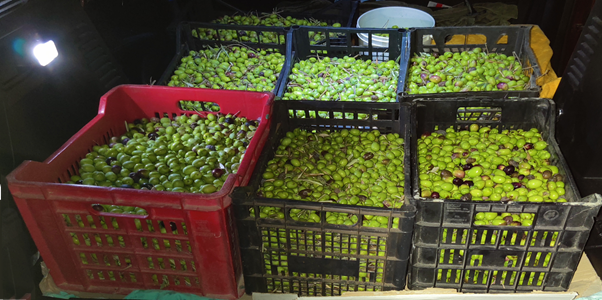
I piccoli raccoglitori in genere portano il raccolto nelle proprie casse. All'arrivo trasferiscono le olive nelle cassette messe a disposizione dall'azienda. I produttori più grandi caricano le casse vuote sui loro camion e tornano con quelle piene di olive. Ripetono questa impresa ogni giorno finché tutti gli alberi non sono stati abbattuti. Una cassa può contenere fino a 350 kg di olive.

I piccoli produttori normalmente rimangono con il loro raccolto fino al completamento della spremitura. I grandi produttori, invece, depositano le casse piene, consentendo ai dipendenti di Covato di gestire il processo. Hanno i propri serbatoi di stoccaggio dell'olio d'oliva. Quando sono pieni lo trasportano nelle loro aziende. È impressionante vedere pareti di casse in attesa di essere lavorate. In genere, le casse verranno elaborate entro un'ora dal deposito. I produttori processano le olive entro 6 ore dalla raccolta per garantire una qualità ottima.
Nel 2023 l'azienda ha aggiornato i propri macchinari. L'aggiornamento ha aumentato la velocità di lavorazione, riducendo così la perdita di polifenoli e antiossidanti durante la lavorazione.
Il processo
Ad ogni cliente viene assegnata una referenza. Le casse vengono trasportate utilizzando un carrello elevatore dall'area di attesa alla bilancia. Un sistema automatizzato registrerà il peso poiché questo verrà utilizzato per calcolare la resa. In genere, da 100 kg di olive si producono dai 10 ai 15 litri di olio. Fattori come l’età degli alberi, la varietà, le condizioni climatiche durante l’anno e altre azioni come la potatura influiscono sulla resa. Un altro fattore che determina la resa è il livello di maturazione delle olive. Le olive verdi producono una resa inferiore ma un gusto più intenso rispetto alle olive nere spremute più tardi nella stagione
Dopo la pesatura, il carrello elevatore prende ogni cassa e la svuota in un'unità che separa le olive ancora attaccate al raspo, rimuovere eventuali detriti, lava le olive e le asciuga.

Foglie e altri detriti vengono automaticamente trasportati nei contenitori di contenimento, dove verranno smaltiti. Le olive vengono depositate in un luppolo per la successiva fase di lavorazione. Il processo dura circa 2 minuti per 350 kg.
Le olive vengono poi macinate fino a ottenere una pasta e la miscela viene trasferita in un serbatoio di raccolta, dove viene trasferita in una delle unità di fermentazione. Le unità di fermentazione vengono utilizzate per esaltare il sapore dell'olio. Il processo è completamente automatizzato e tutto ciò che l'operatore deve fare è toccare uno schermo per dirigere il flusso verso un'unità libera.
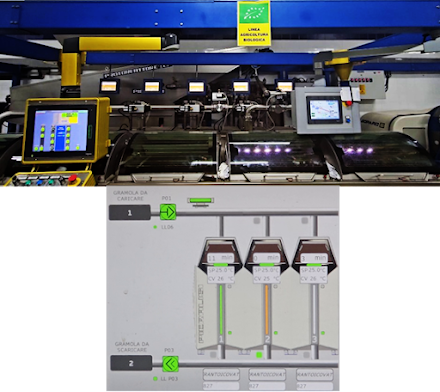
Nei fermentatori la pasta viene costantemente aerata e ruotata e la sua temperatura è controllata per garantire la massima espressione dell'aroma. La durata del processo è programmata nel sistema e i fermentatori utilizzano luci colorati per indicare visivamente l'avanzamento del processo di fermentazione.
Una volta terminato il processo di fermentazione, la pasta viene trasferita temporaneamente in una zona di sosta e immediatamente dopo, nel protoreattore. Il protoreattore separa l'olio dall'acqua e dai solidi. L'acqua viene scartata, mentre i componenti solidi vengono trasportati tramite condotte sotterranee in aree di contenimento dove verranno trasformati in concime. Questo dispositivo riduce al minimo il tempo di lavorazione della pasta, poiché garantisce la preservazione del sapore, massimizza l'attività antiossidante dei composti fenolici e si traduce nella migliore stabilità ossidativa.

Il protoreattore rimuove il 90% dell'acqua e pui del 99% dei solidi. Un'unità di filtrazione passiva primaria, una centrifuga, e un'unità di filtrazione passiva secondaria rimuovono l'acqua e i solidi rimanenti.
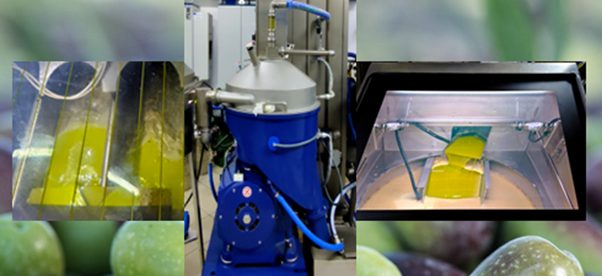
L'olio extra vergine di oliva appena franto è opaco perché nell'olio è sospeso un sedimento. Per questo motivo viene definito non filtrato . È di colore verde smeraldo e l'odore è semplicemente incredibile. La tentazione di deviare parte del flusso in un piattino e assorbire tutta questa bontà con il pane modicano è immensa. Chi ha franto l'olio almeno una volta, lo avrebbe fatto appena arrivato a casa, se non al frantoio. Alcuni lo usano come giustificazione per "assaggiare" la qualità dell'olio. La temperatura dell'olio è compresa tra 20°C (68°F) e 25°C (77°F).
La dimensione del contenitore in cui viene raccolto l'olio extravergine di oliva appena franto dipende dalla quantità iniziale di olive. I contenitori variano dalle taniche monouso da 3 litri fino ai serbatoi riutilizzabili in acciaio inossidabile che immagazzinano migliaia di litri. I produttori commerciali sostituiscono l'aria nei loro serbatoi con azoto alimentare per garantire che l'ossigeno nell'aria non reagisca con l'olio.
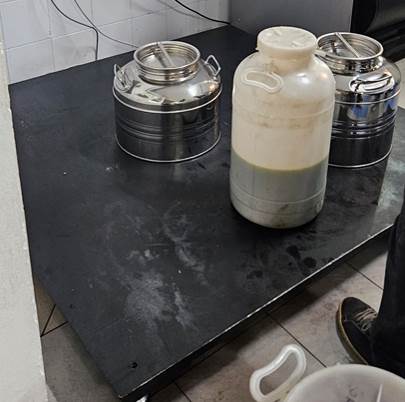
La resa viene calcolata confrontando il peso netto rilevato all'inizio del processo con il volume d’olio d'oliva alla fine.
In poche settimane, il sedimento nell'olio non filtrato si deposita sul fondo, lasciando il liquido verde-dorato semitrasparente tipicamente associato con l'olio d'oliva. Questo sedimento è conosciuto come morchia. Chi ha accesso all'olio appena franto può godere il prodotto ancora arricchito di sedimenti. Una volta formato il sedimento, la morchia viene scartata.
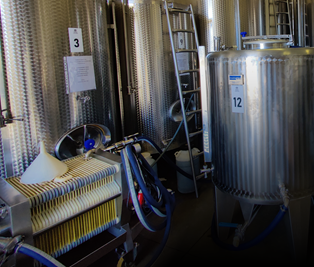 I produttori che imbottigliano l'olio da vendere commercialmente filtrano l'olio d'oliva per rimuovere eventuali sedimenti prima dell'imbottigliamento. Nella foto sotto, l'unità di filtraggio è vista a sinistra.
I produttori che imbottigliano l'olio da vendere commercialmente filtrano l'olio d'oliva per rimuovere eventuali sedimenti prima dell'imbottigliamento. Nella foto sotto, l'unità di filtraggio è vista a sinistra.
Conservazione dell'olio extra vergine di oliva
L'olio d'oliva deve essere conservato in un luogo fresco, lontano dalla luce e con meno ossigeno possibile. Le foto delle varie schermate condivise evidenziano come ogni fase del processo è a temperatura controllata. Conservare l'olio d'oliva in un ambiente caldo farà ciò che il frantoio ha lavorato duramente per evitare. Allo stesso modo, la luce dovrebbe essere evitata conservando l’olio lontano dalla luce diretta. Una dispensa buia e fresca aiuta a conservare il gusto e gli attributi dell'olio.
La spremitura dell'olio d'oliva è un'esperienza fantastica, anche se rumorosa. Frantoi come quelli dei fratelli Covato permettono ai committenti di seguire il processo da un distanza sicura ma allo stesso tempo vicino. Chi ha la fortuna di avere delle olive da frangere se ne andrà con un rispetto maggiore per uno dei prodotti base della dieta mediterranea.

Alcuni fatti interessanti
|
Tuesday, 19 December 2023
How Extra Virgin Olive Oil is Made
This is the narrative of how extra virgin olive oil is produced. We pressed our olive oil at Frantoi Covato, a company located in San Giacomo, within the province of Ragusa, Sicily. This oil mill has been pressing olives since 1985. Today, it is run and operated by brothers Orazio and Giuseppe Covato, who are hands-on in the entire operation. Many thanks to them and their employees for their help and assistance with this story.
Frantoi Covato specialises in the cold pressing of olives. Cold extraction is a traditional method of extracting oil from olives. It is a mechanical process that does not involve the use of heat or chemicals. The indication “cold extraction” may appear only for virgin or extra virgin olive oils obtained at a temperature below 27°C (80.6°F). The resulting extra-virgin olive oil is pure and unrefined, with all its natural nutrients and antioxidants intact. This is the type of olive oil that is associated with the Mediterranean diet.

The Covato oil mill runs from mid-September to mid-December. It has two separate lines and can process up to ten concurrent presses. The company serves a geographically wide area, and owners of olive groves of all sizes gravitate to this place during this period like moths to a flame. To serve clients, Frantoi Covato typically runs 12 hours a day, peaking at around 20 hours to meet demand.
Tonda Iblea, Moresca, and Verdese are the olive varieties that are grown in this region. These olives and the olive oil produced here carry the European Union DOP, IGP, and BIO food certifications.
DOP (POD in English) stands for Denominazione di Origine Protetta (Protected Designation of Origin) and indicates that a product owes its characteristics to its place of origin, and its production, modification, and processing occur within that geographical area. IGP (PGI in English) stands for Indicazione Geografica Tipica (Protected Geographical Indication) and identifies agricultural products for which their quality, reputation, or other important characteristic depends on their production, processing, and/or preparation taking place in a defined geographical area with at least one stage of production tied to the geographical location that has, over time, stood out for its quality and reputation. BIO means that the item was grown following the rules of the EU Regulation on Organic Farming. For processed foods, the label BIO means that at least 95% of the ingredients of agricultural origin come from organic farming (the EU allows the remaining 5% for external material carried by rain and wind). For a product to achieve the BIO mark, it must not use genetically modified or radiated products or products with additives or stabilisers. The Italian Ministry of Agriculture is responsible for these certifications.
The oil mill serves clients of all sizes. On the smaller side, one finds foreigners who own property with land that has olive trees. These typically visit every year around this time for the harvesting adventure. They normally consume the olive oil they produce and gift family and friends with bottles of “this year’s pressing." The more refined will even print decorative labels to mark the content and the vintage.
Other groups that press their oil are locals who have emigrated for economic reasons. It is customary, around this time, for children to gravitate to their parent’s house to help with the olive harvest and, over typical Ragusan meals, catch up with siblings. Three and sometimes four generations cram into a house for a few days. At the end of this adventure, everyone has caught up on the latest gossip, contributed their own, and will be returning home with a few bottles of nectar from “our land.”

Small harvesters typically bring in their harvest in their own crates. Upon arrival, they transfer the olives into the crates provided by the company. Larger producers load empty crates onto their trucks and return with them filled with olives. They repeat this undertaking daily until all the trees have been harvested. A crate holds 350kg of olives.

Small producers normally remain with their harvest until the pressing is complete. On the other hand, large producers deposit the filled crates, allowing Covato employees to manage the process. They have their own olive oil storage tanks, which they transport to their premises when full. It is quite impressive to see walls of crates waiting to be processed. Typically, the crates will be processed within an hour of being deposited. Producers process the olives within 6 hours of collection to ensure optimal quality.
During 2023, the company upgraded its equipment. The upgrade increased the processing speed, thereby reducing the loss of polyphenols and antioxidants during processing.
The Process
Every client is assigned a reference. Their crates are transported using a forklift from the waiting area to the weighing scales. An automated system will record the weight since this will be used to compute the yield. Typically, 100 kg of olives will produce between 10 and 15 litres of oil. Factors such as tree age, variety, climate conditions during the year, and other actions such as pruning impact the yield. Another factor that determines yield is the level of maturity of the olives. Green olives produce a lower yield but a more intense taste compared to brown olives pressed later in the season.
After the weighing, the forklift takes each crate and empties it into a unit that separates any olives still attached to a stalk, removes any debris, washes the olives, and dries them.

Leaves and other debris are automatically shuttled out into containment bins, where they will be disposed of. The olives are deposited in a hop for the next stage of processing. The process takes around 2 minutes per 350kg.
The olives are then ground up into a paste, and the mixture is moved into a holding tank, where it's transferred to one of the fermenting units. The fermenting units are used to bring out the flavour of the oil. The process is fully automated, requiring the operator to programme the transfer to a vacant unit using a touch screen.

In the fermenters, the paste is constantly aerated and rotated, and its temperature is controlled to ensure that the aroma is maximised. The duration of the process is programmed into the system, and the fermenters use coloured LEDs to visually indicate the progress of the fermentation process.
Once the fermentation process is complete, the paste is transferred into a temporary holding area and then into the protoreactor. The protoreactor separates the oil from the water and the solids. The water is discarded, while the solid components are transported via underground ducts to holding areas where they will be transformed into compost. This device minimises the time the paste is processed, as this ensures that flavour is preserved, maximises the antioxidant activity of the phenol compounds, and results in the best oxidative stability.

The protoreactor removes 90% of the water and more than 99% of the solids. A primary passive filtration unit, a centrifuge, and a secondary passive filtration unit remove the remaining water and solids.

Freshly pressed extra virgin olive is opaque because suspended in the oil is sediment. It is referred to as non-filtered. It is emerald-green in colour, and the smell is simply incredible. The temptation to divert some of the flow into a saucer and soak up all this goodness with Modican bread is immense. Anyone who has pressed olive oil at least once would have done so upon arriving home, if not at the mill. Some use this as a justification to "sample" the quality of the oil. The temperature of the oil is in the low to mid-20°C (68°F).
The size of the container into which the freshly pressed extra virgin olive oil is collected depends on the quantity of olives that are being pressed. The range varies from 3-litre, one-time-use jerry cans to reusable stainless-steel tanks that store thousands of litres. The commercial producers replace the air in their tanks with food-grade nitrogen to ensure that the oxygen in the air does not react with the oil.

The yield is computed by comparing the net weight taken at the start of the process to the quantity of olive oil collected at the end.
Over a few weeks, the sediment in non-filtered oil will settle to the bottom, leaving the semi-transparent golden-green liquid one typically associates with olive oil. This sediment is known as morchia in Italian. Those who have access to freshly pressed oil can use the product while it is still enriched with sediment. Once the sediment forms, the morchia is discarded.
 Producers bottling the oil to be sold commercially filter the olive oil to remove any sediment prior to bottling. In the photo below, the filtering unit is seen on the left.
Producers bottling the oil to be sold commercially filter the olive oil to remove any sediment prior to bottling. In the photo below, the filtering unit is seen on the left.
Storing extra virgin olive oil
Olive oil should be stored in a cool place away from light and with as little oxygen as possible. Photos of the various screens shared here highlight how every stage of the cold pressing process is temperature-controlled. Storing olive oil in a hot environment will do to it what the mill worked hard to avoid. Likewise, light should be avoided by storing the oil away from direct light. A pantry that is dark and cool helps retain the taste and attributes of the oil.
Olive oil pressing is a fantastic experience, albeit a noisy one. Oil mills like those of the Covato brothers allow patrons to follow the process from a close yet safe distance. Anyone who is lucky enough to have olives for pressing will walk away with a greater respect for one of the staple products of the Mediterranean diet.

Additional interesting facts
|
Wednesday, 15 November 2023
Solenni Festeggiamenti in onore della Beata Maria Vergine di Lourdes (2012)
PDF Version
PDF Version
Version of the document improved using Artifical Intelligence / Versione del documento migliorata utilizzando l'Intelligenza Artificiale
-
Questo è il racconto di come viene prodotto l’olio extravergine di oliva. Abbiamo frantumato le nostre olive presso Frantoi Covato, un azie...
-
This is the narrative of how extra virgin olive oil is produced. We pressed our olive oil at Frantoi Covato, a company located in San Giaco...





